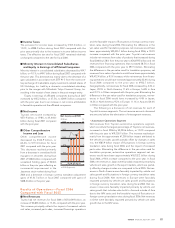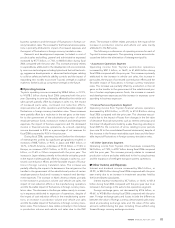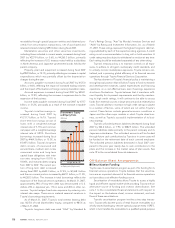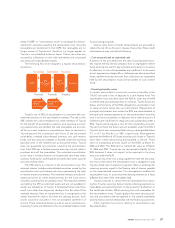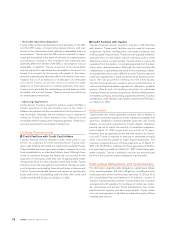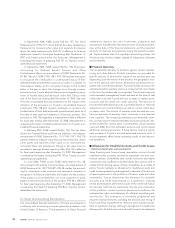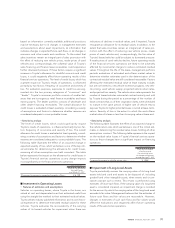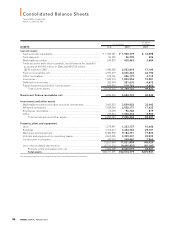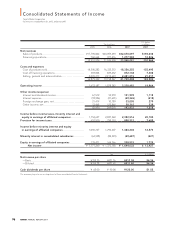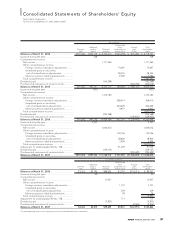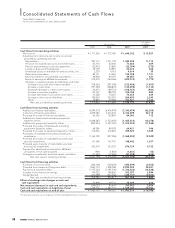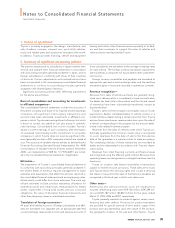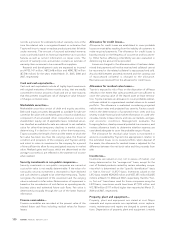Toyota 2007 Annual Report Download - page 93
Download and view the complete annual report
Please find page 93 of the 2007 Toyota annual report below. You can navigate through the pages in the report by either clicking on the pages listed below, or by using the keyword search tool below to find specific information within the annual report.
ANNUAL REPORT 2007 91
based on information currently available, additional provisions
may be necessary due to (i) changes in management estimates
and assumptions about asset impairments, (ii) information that
indicates changes in expected future cash flows, or (iii) changes in
economic and other events and conditions. To the extent that
sales incentives remain an integral part of sales promotion with
the effect of reducing new vehicle prices, resale prices of used
vehicles and, correspondingly, the collateral value of Toyota’s
sales financing and finance lease receivables could experience
further downward pressure. If these factors require a significant
increase in Toyota’s allowance for doubtful accounts and credit
losses, it could negatively affect future operating results of the
financial services operations. The level of credit losses, which has
a greater impact on Toyota’s results of operations, is influenced
primarily by two factors: frequency of occurrence and severity of
loss. For evaluation purposes, exposures to credit loss are seg-
mented into the two primary categories of “consumer” and
“dealer”. Toyota’s consumer portfolio consists of smaller bal-
ances that are homogenous retail finance receivables and lease
earning assets. The dealer portfolio consists of wholesale and
other dealer financing receivables. The overall allowance for
credit losses is evaluated at least quarterly, considering a variety
of assumptions and factors to determine whether reserves are
considered adequate to cover probable losses.
• Sensitivity analysis
The level of credit losses, which could significantly impact
Toyota’s results of operations, is influenced primarily by two fac-
tors: frequency of occurrence and severity of loss. The overall
allowance for credit losses is evaluated at least quarterly, consid-
ering a variety of assumptions and factors to determine whether
reserves are considered adequate to cover probable losses. The
following table illustrates the effect of an assumed change in
expected severity of loss, which we believe is one of the key criti-
cal estimates for determining the allowance for credit losses,
assuming all other assumptions are held consistent. The table
below represents the impact on the allowance for credit losses in
Toyota’s financial services operations as any change impacts
most significantly on the financial services operations.
Yen in millions
Effect on the allowance
for credit losses
as of March 31, 2007
10 percent increase in expected severity of loss... ¥ 6,139
■Investment in Operating Leases
• Natures of estimates and assumptions
Vehicles on operating leases, where Toyota is the lessor, are
valued at cost and depreciated over their estimated useful lives
using the straight-line method to their estimated residual values.
Toyota utilizes industry published information and its own histori-
cal experience to determine estimated residual values for these
vehicles. Toyota evaluates the recoverability of the carrying
values of its leased vehicles for impairment when there are
indications of declines in residual values, and if impaired, Toyota
recognizes an allowance for its residual values. In addition, to the
extent that sales incentives remain an integral part of sales pro-
motion with the effect of reducing new vehicle prices, resale
prices of used vehicles and, correspondingly, the fair value of
Toyota’s leased vehicles could be subject to downward pressure.
If resale prices of used vehicles decline, future operating results
of the financial services operations are likely to be adversely
affected by incremental charges to reduce estimated residual
values. Throughout the life of the lease, management performs
periodic evaluations of estimated end-of-term market values to
determine whether estimates used in the determination of the
contractual residual value are still considered reasonable. Factors
affecting the estimated residual value at lease maturity include,
but are not limited to, new vehicle incentive programs, new vehi-
cle pricing, used vehicle supply, projected vehicle return rates,
and projected loss severity. The vehicle return rate represents the
number of leased vehicles returned at contract maturity and sold
by Toyota during the period as a percentage of the number of
lease contracts that, as of their origination dates, were scheduled
to mature in the same period. A higher rate of vehicle returns
exposes Toyota to higher potential losses incurred at lease termi-
nation. Severity of loss is the extent to which the end-of-term
market value of a lease is less than its carrying value at lease end.
• Sensitivity analysis
The following table illustrates the effect of an assumed change in
the vehicle return rate, which we believe is one of the critical esti-
mates, in determining the residual value losses, holding all other
assumptions constant. The following table represents the impact
on the residual value losses in Toyota’s financial services opera-
tions as those changes have a significant impact on financing
operations.
Yen in millions
Effect on the residual
value losses over
the remaining terms
of the operating leases
on and after April 1, 2007
1 percent increase in vehicle return rate............... ¥ 1,062
■Impairment of Long-Lived Assets
Toyota periodically reviews the carrying value of its long-lived
assets held and used and assets to be disposed of, including
goodwill and other intangible assets, when events and circum-
stances warrant such a review. This review is performed using
estimates of future cash flows. If the carrying value of a long-lived
asset is considered impaired, an impairment charge is recorded
for the amount by which the carrying value of the long-lived asset
exceeds its fair value. Management believes that the estimates of
future cash flows and fair values are reasonable. However,
changes in estimates of such cash flows and fair values would
affect the evaluations and negatively affect future operating
results of the automotive operations.


